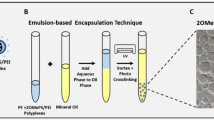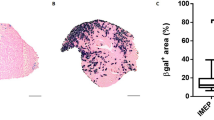Abstract
Intramuscular injection of naked plasmid DNA is a safe approach to the systemic delivery of therapeutic gene products, but with limited efficiency. We have investigated the use of microbubble ultrasound to augment naked plasmid DNA delivery by direct injection into mouse skeletal muscle in vivo, in both young (4 weeks) and older (6 months) mice. We observed that the albumin-coated microbubble, Optison (licensed for echocardiography in patients), significantly improves the transfection efficiency even in the absence of ultrasound. The increase in transgene expression is age related as Optison improves transgene expression less efficiently in older mice than in younger mice. More importantly, Optison markedly reduces muscle damage associated with naked plasmid DNA and the presence of cationic polymer PEI 25000. Ultrasound at moderate power (3 W/cm2 1 MHz, 60 s exposure, duty cycle 20%), combined with Optison, increases transfection efficiency in older, but not in young, mice. The safe clinical use of microbubbles and therapeutic ultrasound and, particularly, the protective effect of the microbubbles against tissue damage provide a highly promising approach for gene delivery in muscle in vivo.
This is a preview of subscription content, access via your institution
Access options
Subscribe to this journal
Receive 12 print issues and online access
$259.00 per year
only $21.58 per issue
Buy this article
- Purchase on Springer Link
- Instant access to full article PDF
Prices may be subject to local taxes which are calculated during checkout







Similar content being viewed by others
References
Dwarki VJ et al. Gene therapy for hemophilia A: production of therapeutic levels of human factor VIII in vivo in mice. Proc Natl Acad Sci USA 1995; 92: 1023–1027.
Chao H et al. Several log increase in therapeutic transgene delivery by distinct adeno-associated viral serotype vectors. Mol Ther 2000; 2: 619–623.
Hagstrom JN . Improved muscle-derived expression of human coagulation factor IX from a skeletal actin/CMV hybrid enhancer/promoter. Blood 2000; 95: 2536–2542.
Wang B, Li J, Xiao X . Adeno-associated virus vector carrying human minidystrophin genes effectively ameliorates muscular dystrophy in mdx mouse model. Proc Natl Acad Sci USA 2000; 97: 13 714–13 719.
Xiao X et al. Full functional rescue of a complete muscle (TA) in dystrophic hamsters by adeno-associated virus vector-directed gene therapy. J Virol 2000; 74: 1436–1442.
Drittanti L et al. Optimised helper virus-free production of high-quality adeno-associated virus vectors. J Gene Med 2001; 3: 59–71.
Nakai H et al. Extrachromosomal recombinant adeno-associated virus vector genomes are primarily responsible for stable liver transduction in vivo. J Virol 2001; 75: 6969–6976.
Miller DG, Rutledge EA, Russell DW . Chromosomal effects of adeno-associated virus vector integration. Nat Genet 2002; 30:147–148.
McMahon JM et al. Inflammatory responses following direct injection of plasmid DNA into skeletal muscle. Gene Ther 1998; 5: 1283–1290.
McMahon JM et al. Optimisation of electrotransfer of plasmid into skeletal muscle by pretreatment with hyaluronidase – increased expression with reduced muscle damage. Gene Ther 2001; 8: 1264–1270.
Fechheimer M et al. Transfection of mammalian cells with plasmid DNA by scrape loading and sonication loading. Proc Natl Acad Sci USA 1987;84:8463–8467.
Manome Y, Nakamura M, Ohno T, Furuhata H . Ultrasound facilitates transduction of naked plasmid DNA into colon carcinoma cells in vitro and in vivo. Hum Gene Ther 2000; 11: 1521–1528.
Lawrie A et al. Microbubble-enhanced ultrasound for vascular gene delivery. Gene Ther 2000; 7: 2023–2027.
Koch S, Pohl P, Cobet U, Rainov NG . Ultrasound enhancement of liposome-mediated cell transfection is caused by cavitation effects. Ultrasound Med Biol 2000; 26: 897–903.
Anwer K et al. Ultrasound enhancement of cationic lipid-mediated gene transfer to primary tumors following systemic administration. Gene Ther 2000; 7: 1833–1839.
Newman CM, Lawrie A, Brisken AF, Cumberland DC . Ultrasound gene therapy: on the road from concept to reality. Echocardiography 2001; 18: 339–347.
Amabile PG et al. High-efficiency endovascular gene delivery via therapeutic ultrasound. J Am Coll Cardiol 2001; 37: 1975–1980.
Levy MY, Barron LG, Meyer KB, Szoka Jr. FC . Characterization of plasmid DNA transfer into mouse skeletal muscle: evaluation of uptake mechanism, expression and secretion of gene products into blood. Gene Ther 1996; 3: 201–211.
Alila H et al. Expression of biologically active human insulin-like growth factor-I following intramuscular injection of a formulated plasmid in rats. Hum Gene Ther 1997; 8: 1785–1795.
Tachibana K et al. Induction of cell-membrane porosity by ultrasound. Lancet 1999; 353: 1409.
Nguyen HK et al. Evaluation of polyether–polyethyleneimine graft copolymers as gene transfer agents. Gene Ther 2000; 7: 126–138.
Campeau P et al. Transfection of large plasmids in primary human myoblasts. Gene Ther 2001; 8: 1387–1394.
Taniyama Y et al. Development of safe and efficient novel nonviral gene transfer using ultrasound: enhancement of transfection efficiency of naked plasmid DNA in skeletal muscle. Gene Ther 2002; 9: 372–380.
Dunn F, Pond JB . Selected non-thermal mechanisms of interaction of ultrasound and biological media. In: Fry FJ (ed). Ultrasound: Its Applications in Medicine and Biology. Elsevier: Amsterdam, 1978, pp 539–560.
Shi WT et al. Destruction of contrast microbubbles and the association with inertial cavitation. Ultrasound Med Biol 2000; 26: 1009–1019.
Schultz E, Lipton BH . Skeletal muscle satellite cells: changes in proliferation potential as a function of age. Mech Ageing Dev 1982; 20: 377–383.
Bockhold KJ, Rosenblatt JD, Partridge TA . Aging normal and dystrophic mouse muscle: analysis of myogenicity in cultures of living single fibers. Muscle Nerve 1998; 21: 173–183.
Jiao S et al. Direct gene transfer into nonhuman primate myofibers in vivo. Hum Gene Ther 1992; 3: 21–33.
Vitadello M et al. Gene transfer in regenerating muscle. Hum Gene Ther 1994; 5: 11–18.
Davis HL et al. Plasmid DNA is superior to viral vectors for direct gene transfer into adult mouse skeletal muscle. Hum Gene Ther 1993; 4: 733–740.
Mumper RJ, Rolland AP . Plasmid delivery to muscle: Recent advances in polymer delivery systems. Adv Drug Deliv Rev 1998; 30: 151–172.
Caron NJ et al. Intracellular delivery of a Tat-eGFP fusion protein into muscle cells. Mol Ther 2001; 3: 310–318.
Ruponen M et al. Extracellular glycosaminoglycans modify cellular trafficking of lipoplexes and polyplexes. J Biol Chem 2001; 276: 33 875–33 880.
Villanueva FS, Jankowski RJ, Manaugh C, Wagner WR . Albumin microbubble adherence to human coronary endothelium: implications for assessment of endothelial function using myocardial contrast echocardiography. J Am Coll Cardiol 1997; 30: 689–693.
Schnitzer JE, Carley WW, Palade GE . Specific albumin binding to microvascular endothelium in culture. Am J Physiol 1988; 254: H425-H437.
Schnitzer JE, Oh P . Antibodies to SPARC inhibit albumin binding to SPARC, gp60, and microvascular endothelium. Am J Physiol 1992; 263: H1872-H1879.
Acknowledgements
The authors thank Dr Bou-Gharios G, Muscle Cell Biology, MRC Clinical Science Centre (CSC), Hammersmith Campus, London, UK, for critical discussions on in vivo experiments and help with the preparation of the manuscript. Martin JK Blomley acknowledges core MRC support through CSC, MRC Career Establishment Grant G0100120, and NHS R & D RFG 581 grants. Optison was donated by Amersham Health PLC, Oslo, Norway.
Author information
Authors and Affiliations
Rights and permissions
About this article
Cite this article
Lu, Q., Liang, HD., Partridge, T. et al. Microbubble ultrasound improves the efficiency of gene transduction in skeletal muscle in vivo with reduced tissue damage. Gene Ther 10, 396–405 (2003). https://doi.org/10.1038/sj.gt.3301913
Received:
Accepted:
Published:
Issue Date:
DOI: https://doi.org/10.1038/sj.gt.3301913
Keywords
This article is cited by
-
Synergistic anti-tumor effect of paclitaxel and miR-34a combined with ultrasound microbubbles on cervical cancer in vivo and in vitro
Clinical and Translational Oncology (2020)
-
Nonviral ultrasound-mediated gene delivery in small and large animal models
Nature Protocols (2019)
-
Delivery of the gene encoding the tumor suppressor Sef into prostate tumors by therapeutic-ultrasound inhibits both tumor angiogenesis and growth
Scientific Reports (2017)
-
Ultrasound-Mediated Mesenchymal Stem Cells Transfection as a Targeted Cancer Therapy Platform
Scientific Reports (2017)
-
Effects of shRNA-Mediated SOX9 Inhibition on Cell Proliferation and Apoptosis in Human HCC Cell Line Hep3B Mediated by Ultrasound-Targeted Microbubble Destruction (UTMD)
Cell Biochemistry and Biophysics (2015)



